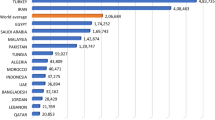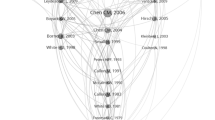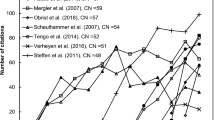Abstract
This study aimed to monitor the status of scientific research in Japan, especially the diversity of scientific research, based on in-depth analyses of science maps. Analyses of six consecutive maps showed decreasing diversity in Japanese science relative to benchmarking countries. We proposed a new concept for a Sci-GEO chart (representing geographical characteristics of research areas on a science map) that aims to classify research areas in terms of continuity and cognitive linkage. Based on the Sci-GEO chart, we classified research areas into four Sci-GEO types, i.e., small island, island, peninsula, and continent, and analysed their properties, such as size and transitions across Sci-GEO types. Our analyses showed that Japanese science put more weight on continent-type research (stable and well-established research), compared with benchmarking countries, and the lack of diversity is attributable to low coverage of small island-type research (research areas with active replacement). We also demonstrated that the Sci-GEO chart well represented the funding characteristics and strategy of two major competitive funding agencies in Japan, and the chart provides policymakers and government officials with baseline information for the planning of science and technology policy.





Similar content being viewed by others
Notes
NISTEP is an institution affiliated with the Ministry of Education, Culture, Sports, Science and Technology. The primary mission of NISTEP is to provide quantitative and qualitative evidence regarding science and technology to the Japanese government.
What we obtained through the clustering is clusters of top 1 % highly cited papers. We used a cluster as a proxy to represent a research area in this study. From Science Map 2002–2008, we provided researchers in Japan with a list of papers that made up of a cluster (consists of six or more research fronts) and asked them to give a name that represents the content of a cluster and a short explanation of the content of a cluster. In this process, almost all researchers were able to give a name to a cluster and were able to provide us with an explanation of the content, therefore we consider that the clusters are feasible, but are not perfect, proxies to represent research areas.
They are (1) agricultural sciences, (2) mathematics, (3) biology and biochemistry, (4) microbiology, (5) chemistry, (6) molecular biology and genetics, (7) clinical medicine, (8) multidisciplinary, (9) computer science, (10) neuroscience and behaviour, (11) economics and business, (12) pharmacology and toxicology, (13) engineering, (14) physics, (15) environment/ecology, (16) plant and animal science, (17) geosciences, (18) psychiatry/psychology, (19) immunology, (20) social sciences, general, (21) materials science, and (22) space science.
Analyses of distribution of co-citation linkages revealed that a growth rate of the number of co-citation linkages that exceeds the threshold of the first clustering (0.3) is lower than a growth rate of the number of top 1 % highly cited papers, i.e., the papers in later years linked less strongly than those in earlier years. The fact results in relatively low growth of the number of research fronts compared to top 1 % highly cited papers and smaller research front clusters over time. This is also reason why many top 1 % highly papers were dropped during the clustering process, especially in later years. Lowering of threshold will increase the number of papers in the clusters, but it would increase the instability of clusters.
The participation in a research area is determined by whether a core paper (or a top 10 % citing paper) of a target country is included in a research area.
Since the participation in a research area is determined by whether a core paper (or a top 10 % citing paper) of a target country is included in a research area, we used the number of publications counted by the whole counting for a denominator.
“Citing papers (top 10 %)” refers to citing papers in the top 10 % of highly cited papers in the world as of the end of 2012. Core papers can be considered those that lead research areas. Citing papers can be thought of as followers because they follow the core papers; accordingly, the citing papers (top 10 %) can be considered the second-tier groups of research areas.
A video showing transitions from Science Map 2002 to Science Map 2012 is available at https://www.youtube.com/watch?v=ZjgvboKRE1o (in Japanese).
Because there are 4 years of overlapping successive science maps, we can calculate the overlap of core papers.
A change in a threshold of the degree of overlapping has impact on the balance of Sci-GEO types. Especially, a decrease of the threshold results in the increase of continent type and island type research areas, however we checked that small island type research areas is still dominant in number.
They are: the president of one of the largest public research institutions in Japan, the president of the largest funding agency of the Ministry of Education, Culture, Sports, Science and Technology (MEXT), a former president of the second largest funding agency of MEXT, the chair of a policy committee that is responsible for academic research, and two high-ranking government officials of MEXT. The interviews were conducted in the summer of 2014.
There are some arguments that the increasing weight of competitive funding leads more researchers to enter research areas where more competitive funds are allocated and to conduct short-sighted research.
References
Börner, K., Chen, C., & Boyack, K. W. (2003). Visualizing knowledge domains. Annual Review of Information Science and Technology, 37(1), 179–255.
Boyack, K. W., & Börner, K. (2003). Indicator-assisted evaluation and funding of research: Visualizing the influence of grants on the number and citation counts of research papers. Journal of the American Society for Information Science and Technology, 54(5), 447–461.
Boyack, K. W., Klavans, R., Small, H., & Ungar, L. (2014). Characterizing the emergence of two nanotechnology topics using a contemporaneous global micro-model of science. Journal of Engineering and Technology Management, 32, 147–159.
Garfield, E., Sher, I. H., & Torpie, R. J. (1964). The use of citation data in writing the history of science. Philadelphia: Institute for Scientific Information.
Ioannidis, J. P. A., Boyack, K. W., Small, H., Sorensen, A. A., & Klavans, R. (2014). Bibliometrics: Is your most cited work your best? Nature, 514, 561–562.
Leydesdorff, L., & Rafols, I. (2009). A global map of science based on the ISI subject categories. Journal of the Association for Information Science and Technology, 60(2), 348–362.
National Institute of Science and Technology Policy. (2014a). Analytical report for 2013 NISTEP expert survey on Japanese S&T and innovation system (2013 NISTEP TEITEN survey). NISTEP Report No. 157 (in Japanese).
National Institute of Science and Technology Policy. (2014b). Japanese science and technology indicators 2013. Research Material No. 229.
Noyons, E. (2001). Bibliometric mapping of science in a policy context. Scientometrics, 50(1), 83–98.
Porter, A. L., & Rafols, I. (2009). Is science becoming more interdisciplinary? Measuring and mapping six research fields over time. Scientometrics, 81(3), 719–745.
Rafols, I., & Meyer, M. (2010). Diversity and network coherence as indicators of interdisciplinarity: Case studies in bionanoscience. Scientometrics, 82(2), 263–287.
Saka, A., & Igami, M. (2007). Mapping modern science using co-citation analysis. In Proceedings of 11th international conference information visualization (IV '07) (pp. 453–458).
Shibata, N., Kajikawa, Y., Takeda, Y., & Matsushima, K. (2008). Detecting emerging research fronts based on topological measures in citation networks of scientific publications. Technovation, 28(11), 758–775.
Shibata, N., Kajikawa, Y., Takeda, Y., Sakata, I., & Matsushima, K. (2010). Detecting emerging research fronts in regenerative medicine by the citation network analysis of scientific publications. Technological Forecasting and Social Change, 78(2), 274–282.
Small, H., Boyack, K. W., & Klavans, R. (2014). Identifying emerging topics in science and technology. Research Policy, 43(8), 1450–1467.
Small, H., & Sweeney, E. (1985). Clustering the science citation index using co-citations. I. A comparison of methods. Scientometrics, 7(3–6), 391–409.
Small, H., Sweeney, E., & Greenlee, E. (1985). Clustering the science citation index using co-citations. II. Mapping science. Scientometrics, 8(5–6), 321–340.
Stirling, A. (2007). A general framework for analysing diversity in science, technology and society. Journal of the Royal Society, Interface, 4(15), 707–719.
Swope, W. C., Andersen, H. C., Berens, P. H., & Wilson, K. R. (1982). A computer simulation method for the calculation of equilibrium constants for the formation of physical clusters of molecules: Application to small water clusters. Journal of Chemical Physics, 76(1), 637–649.
Tomizawa, H., Igami, M., & Saka, A. (2013). High accuracy linkages of KAKEN database and database of scientific publications. Proceedings of the Annual Meeting of Japan Society for Science Policy and Research Management, 28, 1067–1070. (in Japanese).
Author information
Authors and Affiliations
Corresponding author
Appendix: Details about mapping algorithm
Appendix: Details about mapping algorithm
We developed a parallel-mapping technique that can simultaneously generate maps of two different but successive periods. In this technique, a research area experiences attractive and repulsive forces that are caused by interactions with other research areas at the same and different time period, simultaneously.
Two types of attractive forces are considered. The first is the attractive forces among research areas in the same time period. The forces act on a pair of research areas connected by a co-citation linkage. An attractive force between a pair of research areas is calculated by the following relation:
where \(N\left( {{\text{Year}}\,{\text{A}}.i;\,{\text{Year}}\,{\text{A}}.j} \right)\) represents the number of common citing papers between a research area i and a research area j in year A; \(N\left( {{\text{Year}}\,{\text{A}}.i} \right)\) is the number of citing papers in a research area i in year A; and N(Year A.j) is the number of citing papers in a research area j in year A; and r(Year A.i; Year A.j) represents a physical distance between a research area i and a research area j in year A on the map.
The second is the attractive forces between research areas of two successive time periods. The forces act on a pair of research areas that have common core papers and are calculated by the following relation:
where \(N\left( {{\text{Year}}\,{\text{A}}.i;\,{\text{Year}}\,{\text{B}}.j} \right)\) represents the number of common core papers between a research area i in year A and a research area j in year B; \(N\left( {{\text{Year}}\,{\text{A}}.i} \right)\) is the number of core papers in a research area i in year A; and \(N\left( {{\text{Year}}\,{\text{B}}.j} \right)\) is the number of core papers in a research area j in year B; and \(r\left( {{\text{Year}}\,{\text{A}}.i;\,{\text{Year}}\,{\text{B}}.j} \right)\) represents a physical distance between a research area i in year A and a research area j in year B on the map. The second attractive forces are regarded as restraints, which act as glue connecting research areas of two different periods.
We also introduced repulsive forces act on all pairs of research areas in the same period and they are calculated by β/r 2, where β is a parameter to control the repulsive forces. This force is a necessity to avoid the collapse of the map. A net force for a certain research area in year A is calculated by taking a sum of repulsive and attractive forces for all pairs of research areas as the following:
where the first summation is taken over all research areas in year A connected by a co-citation linkage with a research area i in year A; the second summation is taken over all research areas in year B that have common core papers with a research area i in year A; the third summation is taken over all research areas in year A; and the fourth term is a friction term which is proportional to the velocity of a research area. Research areas with similar topics tend to locate closely according to the definition of the attractive force.
In the calculation, all research areas in Science Maps 2004 and 2006 are randomly put in different two-dimensional planes, one for Science Map 2004 and the other for Science map 2006. Then, they are moved incrementally in the direction of net force until a stable configuration is achieved. Positions of research areas are calculated by the Velocity Verlet algorithm (Swope et al. 1982). In the present analysis, the optimisation is continued until the net forces decrease less than a threshold. Several trials were conducted until the most stable results were obtained.
If the attractive forces between 2004 and 2006 maps are set to zero, there is no connection between the two maps, and they are independent. The mapping relies on attractive and repulsive forces among research areas, so only the relative locations of research areas are important. The maps for 2002, 2008, 2010, and 2012 are generated by the parallel mapping of the maps for 2004, 2006, 2008, and 2010, respectively.
Rights and permissions
About this article
Cite this article
Igami, M., Saka, A. Decreasing diversity in Japanese science, evidence from in-depth analyses of science maps. Scientometrics 106, 383–403 (2016). https://doi.org/10.1007/s11192-015-1648-9
Received:
Published:
Issue Date:
DOI: https://doi.org/10.1007/s11192-015-1648-9




